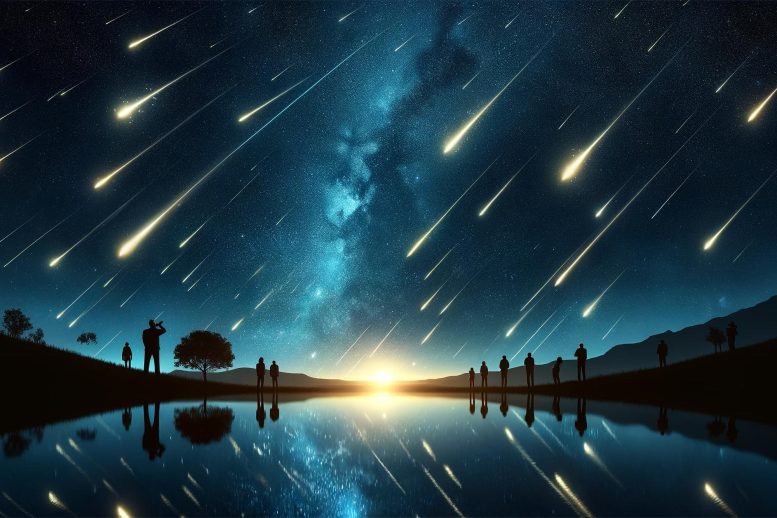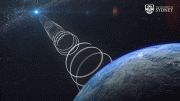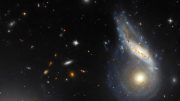
November 2023 skywatching highlights include the peak of the Leonid meteor shower, Saturn in Aquarius, and opposite views of Venus and Jupiter in the morning sky. Credit: SciTechDaily.com
What are some skywatching highlights in November 2023? The Leonid meteors peak, Saturn sits in the celestial sea, and Venus and Jupiter are visible on opposite sides of the sky.
What to Look For:
Meteors and Saturn in “The Sea”
Bundle up and head out to dark skies overnight on November 17 for the peak of the Leonid meteors. Look for Saturn all month long in the constellation Aquarius – just one of several constellations related to water in that part of the sky. And if you’re up before the Sun, you’ll have the opportunity to observe Venus and Jupiter on opposite sides of the sky in the a.m.
November Skywatching Highlights:
- November 9 – Find the crescent moon hanging just beneath Venus in the early morning sky before sunrise this morning.
- November 17 – Look for a beautiful crescent moon sitting low in the southwest all by itself in the twilight following sunset.
- November 20 – After sunset on November 20, look toward the south to see the first quarter moon just below Ringed Planet Saturn. The pair are joined by bright stars Fomalhaut and Altair.
- November 24 – On the 24th, look for the nearly full moon close to giant Jupiter in the east after sunset. Some binoculars will be able to capture both of them in the same field of view.
- November 17 – The annual Leonid meteor shower peaks overnight tonight. The most meteors will be visible between midnight and dawn on the 18th.
- November 13 – New moon
- November 27 – Full moon
- All month – Jupiter is at opposition this month (on Nov. 3), meaning it’s directly opposite the Sun from Earth. It rises around sunset and is in the sky all night long, looking big and bright.
- All month – Venus rises in the couple of hours before dawn. If you’re up before the Sun, you can observe Venus in the eastern sky, and Jupiter in the west.
- All month – Saturn sits within a region of the sky full of constellations related to water, including Aquarius, Pisces, and Capricornus.
Video Transcript
What’s Up for November? Venus and Jupiter on opposite sides of the sky, the Leonid meteors return, and the celestial “sea” surrounding Saturn.
This November, Jupiter is up in the sky all night and sets just before sunrise, while Venus rises in the early morning hours. This means you can see them on opposite sides of the sky if you happen to be up before dawn. You may recall that these two planets appeared super close together just a few months ago, back in March.
On the morning of November 9, find the crescent moon hanging just beneath Venus in the early morning sky before sunrise. Then on the 17th, look for a beautiful crescent moon sitting low in the southwest all by itself in the twilight following sunset. Thanks to the Moon illusion, which causes the rising or setting Moon to look larger, a crescent moon low near the horizon often appears extra captivating.
Then, after sunset on November 20, look toward the south to see the first quarter moon just below Ringed Planet Saturn. The pair are joined by bright stars Fomalhaut and Altair. And then on the 24th, look for the nearly full moon close to giant Jupiter in the east after sunset. Some binoculars will be able to capture both of them in the same field of view.
Finally, in the last few days of November, you’ll notice Venus is rising in the morning with a bright star very close by. That star is Spica, which is actually two massive stars that orbit around each other every 4 days.
The annual Leonid meteor shower returns this month. The shower peaks overnight on November 17th, with the most meteors visible between midnight and dawn on the 18th. The Leonid meteors are dust particles that originate from comet Tempel-Tuttle, which was discovered in 1865 and orbits the Sun every 33 years.
Leonids tend to be bright, with many producing long trains that persist for a few seconds after the initial flash of light. To view the Leonids, find a safe, dark spot away from bright lights, lie down and look straight up. The meteors can appear anywhere in the sky.
This year, the Moon is near its first-quarter phase on the peak night. It sets just a couple of hours after nightfall, so it won’t interfere with viewing Leonids. So bring a warm drink, bundle up, and enjoy your time searching for meteors in the November sky.
Looking toward the south a couple of hours after dark in November, you’ll find the planet Saturn about halfway up the sky. This region of the sky is full of water-related constellations. For that reason, it’s sometimes referred to as “the Sea” or “the Water.”
Saturn currently sits within Aquarius, the water bearer, imagined as a human figure pouring water from a jug. Nearby are Pisces, the fishes, and Capricornus, the strange, mythical sea goat. Just beneath Aquarius is the Southern Fish, and just above him is the Dolphin. To the east of Aquarius you’ll find the constellation Cetus, a sea monster or whale. And next to Cetus is the constellation Eridanus, which represents a long, winding cosmic river.
Now, these star patterns are not particularly bright or easy to pick out. But it is interesting to note that this whole area of the night sky is populated by mythical figures related to water. And speaking of connections between water and wonder, NASA plans to launch its Europa Clipper spacecraft next fall to study Jupiter’s icy moon Europa – which is thought to contain an ocean that might support life. And you can send your
name to Europa, etched on the spacecraft. Visit the link on screen to sign the “message in a bottle” that will be sent across the cosmic sea from Earth to Europa – from one ocean world to another.
Here are the phases of the Moon for November.









Be the first to comment on "Don’t Miss: Leonid Meteor Shower Peak & Saturn in “The Sea”"